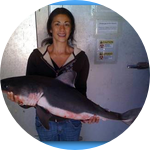About This Project
Aside from their beauty, California kelp forests provide a host of both ecological and economical benefits. Several commercial and recreational species call kelp forests their home, such as lobster, calico bass, abalone, among others. Furthermore, the very presence of kelp forests along the coast provides some relief from beach erosion due to storm surges. While kelp forests and the aforementioned ecosystem services are relatively well-studied, we know little about the California moray, a resident predator that occupies the rocky reefs within this ecosystem. The California moray, the only moray found off the golden state, is elusive and our goal is to uncover its feeding ecology and basic biology providing critical baseline data.
Ask the Scientists
Join The DiscussionWhat is the context of this research?
Despite the widespread concern for predator loss and its cascading effects at various trophic levels, we have a poor understanding of the contribution of top predators, such as moray eels, to the community structure and health of the kelp forest ecosystem.
The combination of a cryptic lifestyle and the lack of a commercial fishery has excluded morays in standard species surveys. Moreover, functional morphology studies of the feeding behavior of moray eels have shown that the pharyngeal jaws of morays enable them to swallow large prey whole. However, we lack information on moray diet, maximum prey size and how often they consume prey. In the present day southern California kelp forest ecosystem, we are unaware of any predators of moray eels which may earn them status as apex predators.
What is the significance of this project?
This proposal will contribute to our over arching goal which is to characterize the effects moray eels have on the kelp forest community around southern California's Catalina Island. Through our organized efforts over the last four years, we have been collecting data on diet, habitat depth, microhabitat preferences, growth, and movement data to provide a better understanding of the basic biology of the California moray.
Collectively, these data will not only provide a better understanding of routine predation in the southern California kelp forest ecosystem, but may be used to inform ecosystem management. Most importantly, this is the first multi-year data set collected for the California moray; it will provide the foundation or benchmark against which changes are measured in future years.
What are the goals of the project?
Our main objectives are to combine our data on moray density, dietary information, and growth rates, with bioenergetic analyses to calculate the energetic needs of the southern California's kelp forest moray population. In 2015 we plan to continue trapping morays to gain more resolution on our dietary data and to use respirometry on a wide size range of morays to determine metabolic rates for this species.
With metabolic data, we will be able to estimate the energetic requirements of the moray population in the kelp forests around Catalina Island. We predict that due to biomass alone, G. mordax has the potential to play a critical role in maintaining community structure within the Channel Islands National Marine Sanctuary.
Budget
One of the most challenging aspects of collecting population data is that annual sampling is critical. Therefore, the funds to support an annual field season are of paramount importance.
All of the funds I have received for my research is channeled directly to my annual field season on Santa Catalina Island. These funds not only go to purchasing the field materials needed each year, but also cover the costs associated with room and board, lab space, waterfront facilities and the food for me and my team of undergraduate researchers. This work requires a lot of man-power, and it can not be effectively conducted with a team fewer than 10 people.
This a great avenue for training and mentoring undergraduate students in field methods and marine biology. Supporting 10 students is a large portion of our field budget. After 4 years of annually sampling the California moray population, we have now run out of funding for the 2015 summer field season.
Meet the Team
Team Bio
From a young age the ocean captivated me. I visited aquariums throughout my childhood. The integration of science, research and education at aquariums continues to have a dramatic influence on me. I supported myself through my Masters at CSUF by working as the Research Supervisor at the Cabrillo Marine Aquarium. The time I spent conducting research while mentoring students on their projects was incredibly fulfilling and taught me that doing research made me a better mentor.
At UCSC, mentoring undergraduates on their theses while pursuing my doctoral degree has helped me realize that I want to pursue a career in science education. Each year when I travel to southern California to conduct fieldwork, I provide a team of 10 undergraduates opportunities to broaden their skillset. This position of simultaneously providing training, and outreach while conducting research motivates me to be the Director of Science Education at a public aquarium in the future.
For more information, please check out our website.
Ben Higgins
Much to the chagrin of my parents, I was always the child that came home filthy. From a very young age, I was interested in the natural world around me. Whether it was living or not, I was interested in it. Rocks, insects, birds, trees were all enough stimulation to keep me outside past dusk. But my curiosity and wonder piqued when I spent weekends on the docks where we had our family sailboat. I spent countless hours hanging my head off the side of the docks, looking at the incredible biodiversity that inhabited such a small space. As I spent more time peering into the ocean, my curiosity swelled. This lead to numerous life-changing experiences, such as becoming S.C.U.B.A certified and experiencing a semester abroad in a Natural and Cultural Ecology Program in Cairns, Australia. In Australia, I spent 5 weeks on the Great Barrier Reef at the Lizard Island Research Station, assisting a Ph.D. candidate with her research while conducing an independent study on the nesting behaviors of the White damselfish. This immersion in marine biology and field work captivated me, and set me on my professional path. I earned my M.S. in 2006. My thesis topic was the jaw mechanics, diet, and feeding behavior of the California grunion and their relatives.
Press and Media
In 2007, we discovered that the pharyngeal jaws of morays eels have the greatest movement of any teleost fish. While all bony fishes have a second set of jaws in their throat to assist them in crushing or winnowing prey, the pharyngeal jaws of morays are used to help them swallow large prey whole. Once the oral jaws have captured prey, the pharyngeal jaws protract up from the throat into the oral cavity, and deliver a second bite onto the prey, transferring the prey into the esophagus. Thus, this mechanisms enables morays to maintain one set of jaws on the prey at all times. These results were featured in the Science Tuesday section of the New York Times and National Geographic.
Additional Information
Acknowledgements for Your Generous Gifts
A donation of any dollar amount will earn acknowledgement on our website.
A donation of $20 or more will earn acknowledgement in a scientific presentation.
A donation of $250 or more will guarantee you updates on an individual moray eel as part of our "Adopt a Moray" program. We will provide you with measurements, PIT tag number, and a photo (that only a mother or father could love) of your very own California Moray eel. We will also update you with recapture measurements during future field seasons.
Inserting a Passive Integrated Transponder (PIT) tag into a moray.
Two members of our happy field crew preparing moray traps in hopes of capturing new tagged individuals.

Project Backers
- 44Backers
- 100%Funded
- $7,540Total Donations
- $164.30Average Donation


